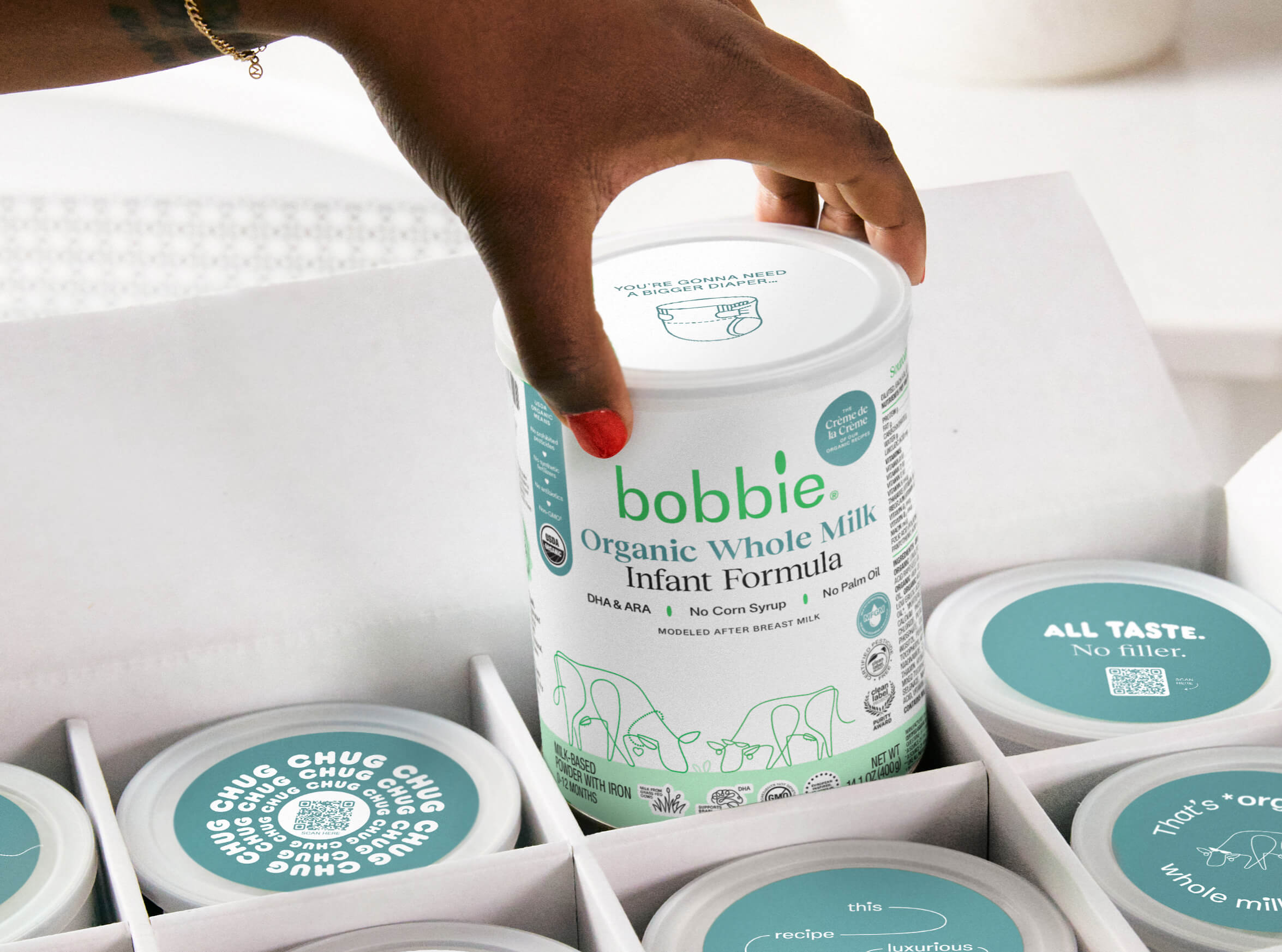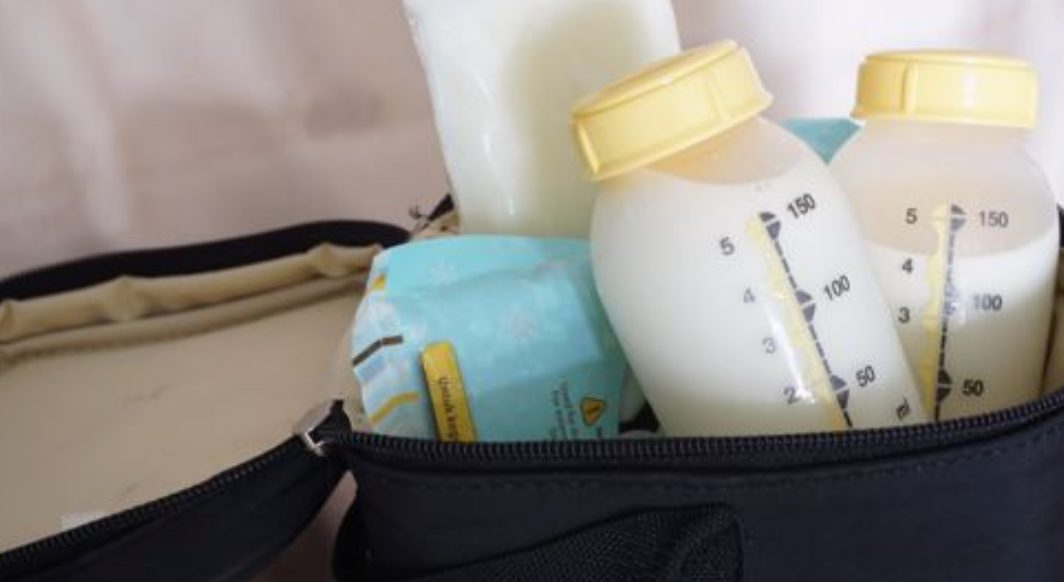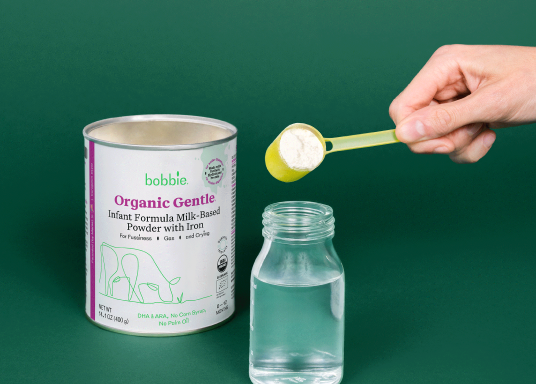Published July 10, 2025

Combo Feeding Baby: A Guide for Parents
Combo feeding — offering both breast milk and formula – is a confident, loving way to feed your baby. Whether you’re navigating a dip in milk supply, easing back into work or simply craving more flexibility, combination feeding gives you the space to meet your baby’s needs and honor your own.
You’re not alone, either! Over 70% of families supplement with formula at some point during their feeding journey — a reassuring reminder that combo feeding is more common than you might think. And it’s not about doing less; it’s about doing what works for you.
In this guide, we’ll walk you through how to start, how to support your breast milk supply and how Bobbie shows up with quality science-backed formula and zero judgment — every step of the way.
What Is Combo Feeding?
Combo feeding, also called combination feeding or mixed feeding, means feeding your baby both breast milk and infant formula and doing what works for your family. It’s not all or nothing. The beauty of combo feeding is that it flexes with your life. You might nurse in the morning, offer a bottle feed of formula at lunch and nurse again at bedtime. Some families combo feed daily, others just when needed. Both are more than OK.
Remember, introducing formula doesn’t cancel out the benefits of breastfeeding. Every drop of human milk still supports your baby’s growth, immunity and gut health. Exclusive breastfeeding is one of many ways to feed a baby, but it’s not the only one.
Fact check: About 1 in 4 breastfed babies are combo fed by 3 months, according to the Centers for Disease Control and Prevention (CDC). So yes, this is common. And yes, you’re doing great!
Why Parents Choose to Combo Feed
Maybe this wasn’t your original plan — or maybe it was. Either way, choosing or needing to combo feed can be a thoughtful, loving decision. Families combination feed for all kinds of reasons, and every one of them is valid. It’s about doing what’s right for you and your baby.
When Breast Milk Supply Is Low
Whether due to birth trauma, hormonal challenges or insufficient glandular tissue, low milk supply can be deeply emotional. Combo feeding gives your baby the nourishment they need from formula, while your milk offers the bioactive components only breast milk can provide
If you're struggling with milk production, a visit with an IBCLC can help you come up with a feeding plan that works for your baby and meets your needs and goals.
When Returning to Work or Needing Flexibility
Some jobs make it very difficult to pump at work. Combo feeding can help families maintain the breastfeeding relationship in the evenings, nighttimes, and weekends, while also providing supplementary nutrition if pumping during work hours is not possible.
When Baby Needs to Gain More Weight
Some babies need a little extra support. If your pediatrician recommends supplementing to support weight gain, combo feeding allows you to respond quickly without ending your breastfeeding journey.
When Feeding Becomes Stressful
Feeding times should be enjoyable for you and your baby. If you find yourself dreading the next feeding session, combo feeding may reduce the pressure that comes with being the sole provider of nutrition for your baby.
Benefits of Combo Feeding
Combo feeding is so much more than just filling bottles. For some, it’s about finding balance in the chaos of parenthood, carving out moments of joy and giving yourself permission to make the choices that work for you.
Combo feeding offers:
-
Flexibility to shape your daily schedule and nighttime routine around your family’s needs
-
Opportunities to share feeding responsibilities with partners and caregivers
-
An option that may make work or travel easier, without sacrificing your baby’s nutrition
-
Continued access to the benefits of breast milk
-
Bonding moments through both breast and bottle feeding

Shop Bobbie Baby Formula
Bobbie infant formulas are clean, EU-style infant formulas that meets all FDA requirements. They are complete nutrition, milk-based powder, modeled after breast milk and is easy on tummies. They are all non-GMO and do not have corn syrup, palm oil, or maltodextrin. Shop Bobbie today!

How To Start Combo Feeding
Starting combo feeding can feel overwhelming, but it doesn’t have to be. With a little patience and the right approach, you and your baby can find a rhythm that works for your family. This isn’t about rushing or perfect schedules — it’s about honoring your and your baby’s unique needs.
Here are four simple steps to help you introduce formula while keeping breastfeeding comfortable and positive for both of you. Need more support? Check out The Feeding Room for expert-curated articles, videos, and registration for weekly IBCLC office hours.
1. Introduce Formula Gradually
Start slow. Swap one feeding session with a formula bottle feed every couple of days. You can combine expressed breast milk and prepared formula in one bottle (just be sure to follow safe prep and storage guidelines). This can help ease your baby into the new taste and texture.
2. Choose the Right Formula
Pick a formula that aligns with your values and your baby’s needs. Bobbie Organic Infant Formula is modeled after breast milk, designed for easy digestion and made without palm oil, corn syrup or maltodextrin.
3. Alternate Breast and Bottle
Keep offering the breast regularly to help maintain breastmilk supply. Use a slow-flow nipple and paced bottle feeding techniques to help prevent nipple confusion and keep feeding cues consistent.
4. Try the “Top Off” Method
Always offer the breast first. If your baby still seems hungry after, offer a small formula top-off. This allows your body to get the breastfeeding signal, while ensuring your baby leaves the feed full and satisfied.
How To Maintain Your Milk Supply While Combo Feeding
Maintaining your milk supply requires keeping up regular breast stimulation, as it works on a supply and demand model. With a few practical tips and a bit of patience, you can support continued milk production while also offering formula.
Here’s how to keep your supply strong while offering formula as part of your routine.
-
Nurse as often as possible, especially during early weeks and months
-
Pump when skipping a feeding routine or replacing with formula
-
Use breast compressions to encourage letdown and milk transfer
-
Stay hydrated and fuel your body with nourishing meals
-
Try power pumping to boost milk production if needed
Sample Combo Feeding Schedules
Sample Schedule Newborn (0–3 Months)
-
Morning: Breastfeed
-
Mid-morning: Formula or expressed milk in a bottle
-
Lunch: Breastfeed
-
Afternoon: Breastfeed + small top-off formula feed if needed
-
Dinner: Formula feed
-
Night: Breastfeed on demand
Sample Schedule Older Baby (4–6 Months)
-
Morning: Breastfeed
-
Mid-morning: Formula feed
-
Lunch: Solids + breast milk or formula
-
Afternoon: Breastfeed
-
Dinner: Formula feed
-
Night: Breastfeed on demand
Common Combo Feeding Concerns
It’s completely normal to have questions! Feeding your baby is a big deal and you deserve clarity, support and peace of mind. Here are some of the most common concerns we hear from parents, with honest, judgment-free answers.
Will I lose my milk supply?
Not if you continue regular milk removal through nursing or pumping. Milk supply works on a demand-and-supply basis, and if you want your body to keep producing milk, you have to remove it often. If you eliminate a nursing or pumping session in favor of a formula bottle, your milk supply may dip.
Will my baby start to prefer bottles?
It’s possible, but you can reduce the risk by using slow-flow nipples, practicing paced bottle feeding and offering the breast often. Babies are adaptable, especially when transitions are gentle.
Will combo feeding confuse my baby?
Most babies handle switching between breast and bottle just fine. A gradual approach, paired with consistency and patience, makes all the difference.
Will formula upset my baby’s digestion?
Some adjustment is normal when introducing formula. Choosing an option with added whey protein, like Bobbie Organic Infant Formula, can support easier digestion and a smoother transition.
Will our bond suffer if I introduce formula?
Not at all. Bonding is built through eye contact, snuggles and responsive care, not just through breastfeeding. Your love comes through no matter how you feed.
Will combo feeding cause nipple confusion?
Not usually. Many babies go back and forth between breast and bottle without trouble when bottles are introduced in a breastfeeding-friendly way.
Will formula cause allergies?
Introducing formula doesn’t automatically cause allergies. If your baby shows signs of sensitivity or intolerance to ingredients — like rashes, diarrhea or blood in the stool — talk to your pediatrician.
Do I have to supplement every feed now?
Not at all. Combo feeding is flexible. Some families supplement once a day, others more often — it’s entirely up to you and what feels sustainable.


Your go-to resource for all things new baby.
Sign up to get the scoop on feeding, sleep, poop, and so much more.
By singing up for email, you are to receive marketing emails from Bobbie and can manage your email preferences or unsubscribe at anytime
Combo Feeding Safety Tips
-
Always follow your formula’s mixing instructions on the back of the container
-
Use or toss formula within 1 hour of the start of a feeding
-
Never microwave bottles — warm with hot water instead
-
Watch for signs of intolerance (rash, vomiting, blood in stool)
-
Reach out to a lactation consultant or pediatrician for personalized guidance
Common Misconceptions About Combo Feeding
Let’s bust a few myths while we’re here:
Myth: Combo feeding ruins breastfeeding
Truth: Many parents successfully maintain breastfeeding while supplementing with formula
Myth: Once you start formula, supply dries up
Truth: Supply works on demand — nursing or pumping frequently keeps production going
Myth: You have to choose one feeding method
Truth: Flexibility is a strength, and the majority of US families combo feed at some point during their baby’s first year
Myth: Babies get confused by switching
Truth: Babies are adaptable when the transition is gradual and gentle
The Bobbie Difference: Feed with Confidence
At Bobbie, we believe feeding your baby should feel empowering, not overwhelming. Whether you’re combo feeding, exclusively breastfeeding or formula feeding from the start, your feeding choices deserve support, not scrutiny.
That’s why we created Bobbie Organic Infant Formula: modeled after breast milk, crafted for gentle digestion and made without palm oil, corn syrup or alternative sugars. It’s Clean Label Project Certified for safety and transparency and trusted by hundreds of thousands of families across the country. With flexible subscriptions and inflation-proof pricing, we’re here to make feeding simpler — and a lot less stressful.
You don’t owe anyone an explanation for how you feed your baby. What matters most is that your little one is nourished, loved and thriving — and that you feel confident in how you’re doing it.
You're doing an amazing job!
Explore your options and feed your way — shop Bobbie Formula today.
The content on this site is for informational purposes only and not intended to be a substitute for professional medical advice, diagnosis or treatment. Discuss any health or feeding concerns with your infant’s pediatrician. Never disregard professional medical advice or delay it based on the content on this page.



































